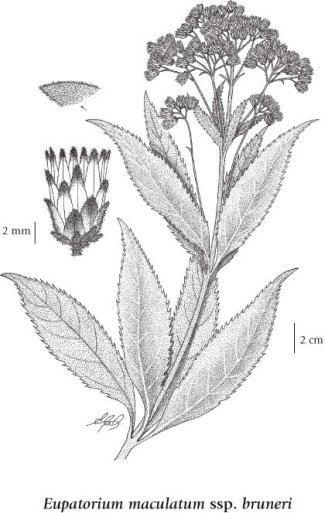Joe-pye weed (spotted Joe-pye-weed)
Asteraceae (Aster family)
Introduction to Vascular Plants
Map
Distribution of Eutrochium maculatum var. bruneri
Click here to view the full interactive map and legend
Introduction
Joe-pye-weed and its three varieties in North America are tall, striking, pink-flowered perennial wetland species. Our variety, var. bruneri, is found in North America mainly west of the Mississippi, in the northern and central United States and in Canada (Ontario west to British Columbia) (USDA 2011). In British Columbia, it is reported from the lower Fraser Valley, with one station reported in the Revelstoke area. Habitat includes "wet to moist swamp or pond margins and forest openings in the lowland zone" (Douglas et al. 1998); it is also found along stream and canal banks, in wet meadows, bogs, and seeps, and on calcareous soils (Flora North America 2011). In the Revelstoke area, it is found in a calcareous fen. This is a summer to fall flowering plant.
Lomer (2011), in his article on rare plants of the Fraser Valley, provides an overview of this variety of Joe-Pye-Weed in British Columbia: "For years it was believed that this outstanding perennial (Joe Pye weed) was merely an introduction from eastern North America where it is quite common. It was collected several times from 1897 to 1926 in the Vancouver area (UBC: Henry s.n.), in the 1940's in Huntingdon, and up to as late as 1955 near Chilliwack. It was assumed, over time, it had died away. But evidence suggests that this taxon is a very rare native that is barely hanging on in the Fraser Valley. Variety bruneri is the western component of a species that is of sporadic and rare occurrence at the westernmost portion of its range. It is believed to be extinct from Washington (Whatcom Co.). A small population existed near Steveston in the Fraser delta, but that disappeared by natural causes by about 2000. In 2007, Eutrochium maculatum var. bruneri was rediscovered on Kirkland Island about 4 km E of the Steveston site (UBC: Lomer 6318). This population seems more secure with about 126 flowering stems counted and is not endangered by any development threats, though it is still a small population that could succumb to disease or eventual crowding by Phalaris arrundinacea L. and Lythrum salicaria L.. It seems to be a very poor reproducer from seed; just one juvenile plant was observed away from the main population. The Huntingdon site is apparently lost to development. The Chilliwack site is from 6 1/2 miles east of town. This would be about Rosedale. There is a slough with potential habitat in the area, but no plants have been observed during more than 10 years of cursory searching. It was observed in Ladner Marsh in the late 1960's (Terry Taylor, personal communication), but it has not been found again, though the habitat is vast. In 2009 a second extant site in the Fraser Valley was discovered by Monica Pearson in a wetland east of Agassiz in the Fraser Valley. The only other known site for E. maculatum var. bruneri in British Columbia is in a wetland southwest of Revelstoke, discovered by Curtis Bjork (UBC: Lomer 7113)." [Reprinted from Botanical Electronic News #435, with permission.]
A detailed description of Joe-pye-weed is provided in Flora North America. |
Species Information
General:
Perennial herb from a fibrous root; stems solitary, stout, branched in the inflorescence, 60-200 cm tall.
Leaves:
Stem leaves opposite or whorled, mostly in 3's or 4's, lanceolate to lance-elliptic, narrowing abruptly to the stalk, 6-20 cm long and 2-7 cm wide, sharply saw-toothed, lower surfaces covered with spreading, curly hairs.
Flowers:
Heads discoid, clustered in somewhat flat-topped clusters, rarely solitary; involucres 6.5-9 mm tall; involucral bracts graduated, often purplish; disk flowers purple, 9-22, tubular and perfect.
Fruits:
Achenes 5-angled, glandular; pappus of numerous hairlike bristles.
Illustration

If more than one illustration is available for a species (e.g., separate illustrations were provided for two subspecies) then links to the separate images will be provided below. Note that individual subspecies or varietal illustrations are not always available.
Illustration Source: The Illustrated Flora of British Columbia
Habitat and Range
Wet to moist swamp or pond margins and forest openings in the lowland zone; rare in the lower Fraser Valley; E to NF and S to UT and NM, probably introduced.Status Information
| Scientific Name | Origin Status | Provincial Status | BC List (Red Blue List) | COSEWIC |
|---|---|---|---|---|
| Eutrochium maculatum var. bruneri | Native | SU | Unknown | Not Listed |
| Eutrochium maculatum var. maculatum | Unlisted | Non-established | Not Listed |
BC Ministry of Environment: BC Species and Ecosystems Explorer.
Synonyms
Synonyms and Alternate Names:
Eupatorium maculatum subsp. bruneri (A. Gray) G.W. Dougl.